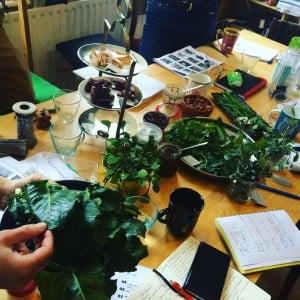On Saturday I had an inspiring day, learning how to make my garden feed me through all seasons, with minimal effort on my part and maximum benefit to the environment. I went along to a Forest Gardening course organised by Edible Landscapes London, a project set up in Finsbury Park aimed at educating people on the value of more sustainable gardening and agricultural practices.
I have always been fascinated by sourcing unusual ingredients while at the same time keeping my cooking as sustainable as possible. This was what first attracted me to foraging and the fact you also get to spend a few hours in nature also adds to the fun.
Forest gardening basically offers the same advantages, with the bonus that what you’re looking for will almost certainly be there (unless frost or slugs got there before you). It follows the principles of agroforestry, which discourages digging unless for planting and promotes a diversity of species coexisting in the same habitat in different layers of vegetation.
The soil is nurtured by the presence of plants with nitrogen fixing and mineral accumulating qualities, and human intervention on it is limited to covering it with mulch when necessary. Such rich soil, alive with fungi, worms, bacteria and little critters, is what we need to grow really nutritious food, as opposed to the dead dust on which monocultures are grown in modern industrial farms. The consequences of this on human health are enormous.
What is brilliant about forest gardens is that many of the plants used are edibles. Most of them are also perennials, which means they have a lifespan of several years and they do not need to be replanted after every single year’s life cycle.
During a few absorbing hours I tasted and listened my way through heaps on information, and with a tasty lunch followed by a walk to the Edible Landscapes site in Finsbury Park, the day breezed by as fast as the wind blowing that day.
And how much information I took in. I learnt that centuries ago chestnuts were a more popular source of carbohydrates than wheat in some parts of Europe. I discovered that when picking elderberries instead of throwing away the ones that are still green you can pickle them and they taste delicious.
I also found out how wonderfully strong the onion-like three cornered leek tastes like, and how the leaves of Shasta daisies can complement your crunchy salad. And who knew you can eat hop shoots and horseradish leaves and that the leaves of the saltbush taste enticingly savoury because the plant draws salts out of the soil?
Forest gardening is brilliant for lazy gardeners like me, and great for the environment because it encourages biodiversity and is way less energy intensive. The plants feed themselves, do not need composting and the whole system helps store water and lock carbon into the soil and plants instead of dispersing it in the atmosphere.
From next week, I will start publishing new recipes based on my finds from the Finsbury Park site. I hope you’ll enjoy them as much as I do and that they will inspire you to get growing these wonderful plants, in your gardens, on your windowsills, everywhere you can. Happy growing and happy cooking!
PS: You can check ELL list of upcoming courses here


